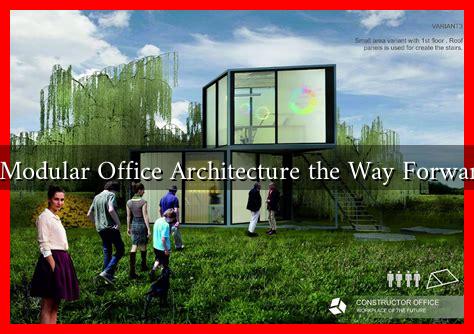-
Table of Contents
Is Modular Office Architecture the Way Forward?
In recent years, the landscape of office design has undergone significant transformations, driven by changing work patterns, technological advancements, and a growing emphasis on sustainability. Among the various architectural innovations, modular office architecture has emerged as a compelling solution. This article explores the benefits, challenges, and future potential of modular office architecture, providing insights into whether it is indeed the way forward for modern workplaces.
Understanding Modular Office Architecture
Modular office architecture refers to the design and construction of office spaces using prefabricated modules or components. These modules can be easily assembled, disassembled, and reconfigured, allowing for flexibility and adaptability in office environments. This approach contrasts with traditional construction methods, which often involve lengthy timelines and significant resource consumption.
Benefits of Modular Office Architecture
Modular office architecture offers several advantages that make it an attractive option for businesses looking to optimize their workspaces:
- Speed of Construction: Modular offices can be built in a fraction of the time compared to traditional structures. According to a report by the Modular Building Institute, modular construction can reduce project timelines by up to 50%.
- Cost-Effectiveness: The streamlined construction process often leads to lower labor costs and reduced material waste. A study by McKinsey & Company found that modular construction can save up to 20% on overall project costs.
- Flexibility and Scalability: Businesses can easily expand or reconfigure their office spaces as needs change. This adaptability is particularly beneficial for startups and companies experiencing rapid growth.
- Sustainability: Modular construction typically generates less waste and can incorporate sustainable materials and energy-efficient designs. The U.S. Green Building Council reports that modular buildings can achieve LEED certification more easily than traditional buildings.
Case Studies: Successful Implementations
Several companies have successfully adopted modular office architecture, showcasing its potential:
- Google: The tech giant has utilized modular designs in its office spaces to create flexible work environments that foster collaboration and innovation.
- Amazon: In its quest for rapid expansion, Amazon has employed modular construction for its fulfillment centers, allowing for quick setup and operational efficiency.
- WeWork: The co-working space provider has embraced modular designs to create adaptable workspaces that cater to diverse client needs, from freelancers to large enterprises.
Challenges to Consider
Despite its numerous benefits, modular office architecture is not without challenges:
- Perception and Acceptance: Some businesses may still view modular offices as inferior to traditional buildings, leading to hesitance in adoption.
- Regulatory Hurdles: Navigating building codes and regulations can be complex, particularly in regions where modular construction is less common.
- Initial Investment: While modular construction can be cost-effective in the long run, the initial investment may be higher than traditional methods, which can deter some businesses.
The Future of Modular Office Architecture
As the demand for flexible and sustainable workspaces continues to grow, modular office architecture is poised to play a significant role in shaping the future of office design. The COVID-19 pandemic has accelerated the shift towards remote and hybrid work models, further emphasizing the need for adaptable office solutions.
According to a survey by Gartner, 47% of organizations plan to allow employees to work remotely full-time post-pandemic. This shift presents an opportunity for modular office designs to cater to fluctuating workforce needs, providing spaces that can be easily modified or expanded as required.
Conclusion
In conclusion, modular office architecture presents a forward-thinking solution to the evolving demands of modern workplaces. With its numerous benefits, including speed, cost-effectiveness, flexibility, and sustainability, it is well-positioned to meet the needs of businesses in a rapidly changing environment. While challenges remain, the successful implementation of modular designs by leading companies demonstrates its potential. As organizations continue to adapt to new work paradigms, modular office architecture may very well be the way forward.
For more information on modular construction and its benefits, you can visit the Modular Building Institute.

